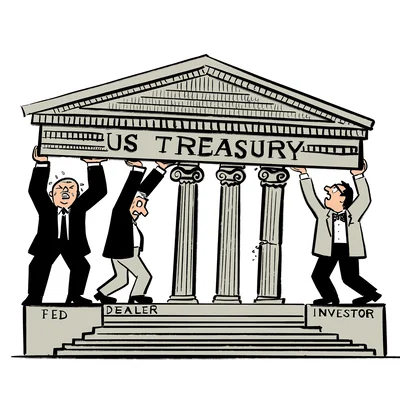

Review of 2021: Default, revolt, reform
Archegos, GameStop, the last days of Libor – markets just about coped in a bleak and disorderly year
A secretive family office triggers one of the biggest trading losses in history. An army of retail investors single-mindedly hunts down short sellers in the stock market. The world’s most important financial benchmark marches inexorably towards death.
While the last of these seismic events was stage-managed – to the extent possible – the others were not. The rise of Reddit’s retail army was anticipated by some, as home-workers ploughed their savings into a Bolshie new form of stock trading, but the explosion it set off in January came as a shock to most. And the failure of Archegos Capital Management was a five-alarm fire. Against the backdrop of a mutating virus and rising global temperatures, this was a precarious, disorderly year.
It was also a story of adaptation and survival. Despite taking huge losses, banks managed the Archegos collapse without systemic tremors. Robinhood Markets, the online discount broker at the centre of the meme-stock frenzy, narrowly avoided defaulting on its clearing obligations. Trillions of dollars of derivatives successfully strapped on their contractual parachutes ahead of Libor’s demise.
None of these stories end with the calendar year, of course. The Archegos debacle has transformed the prime brokerage landscape and could lead to new leverage and risk-taking curbs for hedge funds. The retail trading boom has changed the structure and dynamics of equity markets. And a host of alternative benchmarks – some eyed with contempt by regulators – are vying to fill the void left by US dollar Libor.
Meanwhile, pressure continues to build on financial firms to do their part in the fight against global warming.
Here, we look back at some of the year’s biggest Risk.net articles.
A COLOSSAL FAILURE

When Credit Suisse lost $5.5 billion from the collapse of a single client, it prompted a single question: how?
The simple answer is that the client was allowed to take on far too much leverage. As Risk.net revealed in April, Archegos posted an average margin of just 10% against the equity swaps it traded with Credit Suisse.
But the Swiss bank’s lax margin practices were arguably just the symptom of a deeper malaise. The loss was a case study in everything that can go wrong in a risk-taking business: overworked and underqualified staff; multi-hatting; outdated technology; bad decisions; missed red flags; an aggressive sales culture that overwhelmed risk management; and a lack of accountability and responsibility among senior leaders.
An independent report published in July laid bare the “fundamental failure of management and controls” at Credit Suisse and confirmed much of Risk.net’s earlier reporting. It should be required reading for all risk managers, and anyone involved in investment banking.
“[We’ve had] a 15% floor on single names for decades” – head of risk at a rival clearing bank (Credit Suisse held just 10% margin against Archegos book, April 30)
“It’s not that prime brokerage is inherently risky. It’s that some of these banks are risky because they are Frankenstein creations and nobody knows what’s going on and where the risk is” – Carson Block, founder of Muddy Waters Capital (Credit Suisse and the Wild West of synthetic prime brokerage, May 11)
“This was due in part to a lack of competence (including a failure to appreciate obvious and severe risks) as well as a culture in which profits were prioritised over sound risk management and respect for controls” – independent report on Credit Suisse loss (Archegos report details margin failings at Credit Suisse, August 21)
RIPPLE EFFECTS

This wasn’t just a Credit Suisse story. The collapse of Archegos left at least five large banks with collective losses exceeding $10 billion. The fallout was swift. Nomura suspended its cash prime brokerage operations outside Asia and Credit Suisse exited the business entirely. Others have tightened risk controls or taken a more assertive stance with clients – JP Morgan reminded hedge funds it had the right to call for margin intraday.
The retrenchment is likely to limit credit availability and raise leverage costs for hedge funds, at least in the short-term. Further changes could be coming. One recommendation in the report into Credit Suisse’s loss – giving derivatives valuation adjustment (XVA) desks a wider role in pricing or even vetoing trades with hedge funds – is gaining wider traction in the industry.
The debacle also raised serious questions for regulators. Archegos used equity swaps to acquire huge stakes in a handful of companies without alerting its counterparties or the wider market. Long-delayed margin rules for these instruments finally came into force on November 1. The following month, the US Securities and Exchange Commission proposed new disclosure and anti-fraud rules for security-based swaps. Banking regulators have also signalled that scrutiny of counterparty credit risk management will intensify.
Archegos may have faded from the headlines, but its collapse will reverberate for years.
“Initial margin is precisely there to manage close-out risk on defaulted positions. It may not work every time but it provides a safe, systematic buffering of the system” – Donal Gallagher, president of Quaternion Expert Services (Would margin rules have checked Archegos? Perhaps not, April 14)
“The JP Morgan standard prime brokerage agreement actually says that they can call you whenever they want for variation margin – like you can get up to seven calls a day” – head of treasury at a large US hedge fund (JP Morgan warns hedge funds to expect intraday margin calls, July 13)
“The patchwork of regulatory agencies in the US means that even though one regulator may have the right information, that is not yet guaranteed to extend across all regulators” – Josh Galper, CEO of Finadium (Archegos shows up US swaps reporting shambles, July 13)
“We absolutely have veto or feel free to elevate an outsized risk for a portfolio. All trades over a certain threshold have to be approved by me” – head of XVA at a US bank (After Archegos, a bigger role for XVA desks?, October 6)
WARNING SIGNS

Even before Archegos collapsed, there were hints of excessive leverage in the banking system. An article published by Risk.net on March 1 revealed Nomura had reported more collateral received than total balance sheet assets for the past four years. The discrepancy is explained by the fact that collateral received in securities financing trades can be sold or repledged in other transactions without being recorded on the balance sheet. The last major bank to run up such large off-balance sheet exposures was Lehman Brothers. Nomura had the second-largest exposure to Archegos, with losses totalling $2.9 billion.
But it is by no means the only bank to engage in this sort of off-balance sheet activity. Collateral velocity – the reuse rate of securities in funding transactions – hit its highest level in a decade at the end of 2020, as global banks responded to the hedge fund industry’s growing demand for leverage. An analysis of bank balance sheets suggests the leverage capacity available to hedge funds at the start of 2020 was higher than at any point since the 2008 financial crisis. The off-balance sheet nature of these transactions meant the risks were not adequately captured in the leverage ratio, the regulator’s ultimate backstop against systemic risk.
“The leverage ratio plays the part of a significant brake on the reuse of collateral in the banking sector, so we don’t need to strengthen these rules further. The issue is to apply them to non-bank entities” – Denis Beau, deputy governor of the Banque de France (What lies beneath: Nomura’s iceberg balance sheet, March 1)
“The leverage capacity – both on- and off-balance-sheet – available to hedge funds is higher today than at any point in the past decade” – Manmohan Singh, senior economist at the IMF, and Phil Prince, partner at Pine River Capital Management (Hedge funds and the rebound in collateral velocity, June 7)
RABBLE, ROUSED

Shares of GameStop shot up more than 1,600% in January when internet-savvy retail traders clubbed together to put the squeeze on hedge funds that had bet against the struggling video game retailer. Clearing houses ultimately paused the frenzy, which created huge dislocations in equity markets. Robinhood, the trading app popular with retail investors, halted purchases of GameStop and a handful of other so-called meme-stocks after being hit with a mammoth $2.2 billion capital charge.
The trading limits caused GameStop shares to crash nearly 90% and drew the ire of customers. But things could have turned out even worse. The cash call from the National Securities Clearing Corporation far exceeded Robinhood’s cash on hand and borrowing capacity – it could have been declared in default and its clients’ positions liquidated. NSCC instead used its discretion to waive the charge – a decision that left its largest member firms with mixed feelings.
NSCC’s defenders say liquidating Robinhood even as it was taking steps to lower its risk would have unleashed chaos on the markets. Its critics claim the clearing house’s actions created a moral hazard that might lead to even bigger problems in the future.
Retail investors seem largely unconcerned by the near miss. Many are embracing more complex options strategies and setting their sights on even bigger targets, such as Apple and Tesla. Banks and large asset managers have responded by developing meme-stock factors that seek to track retail flows and capitalise on them. The tug of war between retail and institutional money looks set to continue well into 2022.
“Investors have experience of looking at stocks that are 20%, 30% or 40% volatility, but when you get to 500%, all of a sudden your normal assumptions will go out the window” – Chris Murphy, co-head of strategy at Susquehanna International Group (Options pricing framework buckles under GameStop frenzy, February 3)
“This is a clearing house. They shouldn’t have the option to waive a few billion dollars [from a risk charge]” – chief risk officer at a clearing firm (Hero or villain? NSCC draws fire for Robinhood margin waiver, March 31)
“If we were able to see the likely drivers of these inelasticities, such as more retail participation or more government involvement in markets, that would translate into return predictability” – Vitali Kalesnik, head of research at Research Affiliates (Inelastic markets: how index funds fuelled the meme stock frenzy, April 7)
BUZZ OFF

Transition away from US dollar Libor was thrown into turmoil in March after the market’s key working group warned it would miss a mid-year deadline to approve a term version of its preferred substitute, the secured overnight financing rate, or SOFR.
With the arrival of term SOFR in doubt, loan markets – which were already concerned about the new benchmark’s lack of credit sensitivity – began looking seriously at alternatives, such as Ameribor and the Bloomberg Short-Term Bank Yield (BSBY) index, with the latter garnering the most interest from large banks and corporates.
Bank of America tested the waters with a $1 billion floating rate note referencing BSBY in April, while US workwear company Duluth Holdings became the first corporate to link a syndicated loan to the index in May.
The growing momentum behind BSBY seemed to galvanise a response. On May 21, a working group – the Alternative Reference Rates Committee – selected CME as the official provider of term SOFR and followed through with a full endorsement in July.
But the genie was already out of the bottle. By the summer, the market had seen more than $1 billion notional of swap transactions linked to BSBY, including fixed-to-float instruments out to 10 years, prompting a trenchant response from regulators. At a June meeting on systemic risk, US Securities and Exchange Commission chair Gary Gensler cautioned against widespread use of BSBY, which he said had “many of the same flaws as Libor”. That turned out to be just the opening salvo in a barrage of regulatory attacks that slammed the brakes on credit-sensitive rates ahead of the year-end deadline to cease new Libor issuance. But with lenders still uneasy about risk-free rates, it remains too early to write off BSBY and its peers.
“Our ability to recommend an administrator and endorse a particular rate was always contingent on certain conditions. There’s just been slower take-up [of SOFR derivatives] and some of those conditions haven’t been met” – Tom Wipf, chair of the Alternative Reference Rates Committee (US stumbles in pursuit of term SOFR, March 25)
“It might seem like an improvement on Libor, or a more resilient benchmark, but I would suggest we not make that mistake” – Gary Gensler, chair of the Securities and Exchange Commission (SEC’s Gensler takes aim at Bloomberg’s BSBY index, June 14)
“I’ve never been more bullish about a world of multiple benchmarks” – Richard Sandor, chief executive of the American Financial Exchange (Pick a rate: pitfalls and prizes in the post-Libor world, July 6)
“The regulatory pressures and blocks to BSBY have meant that nobody can proceed with trading it. Even though there is some desire for this as a risk management tool, it is pretty much dead in the water” – head of rates trading at a large European bank (Regulatory attacks deal BSBY swaps a crippling blow, October 12)
FAKE IT TILL YOU MAKE IT

Quants seeking to apply machine learning to finance have run up against a simple reality: a lack of adequate real-word data to train their models. One solution is to create synthetic datasets with the same statistical qualities as the real thing. These so-called market generators spit out vast quantities of realistic but fictional data, which can be used for myriad purposes, from training predictive systems to stress-testing portfolios.
The idea took hold this year. Amundi, Europe’s largest asset manager, began using synthetic data to test some of its volatility trading risk parity strategies. Quants at Bank of America found that a neural network trained using fake data did a better job of forecasting moves in US Treasury bonds than traditional models.
The techniques used to generate synthetic datasets are advancing rapidly. A new paper authored by several prominent quants and published on Risk.net in June proposes using ‘signatures’ – mathematical objects that can quickly and efficiently encode financial data – to create synthetic datasets that capture the essence of financial markets. Models using signatures have been shown to retain information more efficiently than existing data generators and can derive useful information from even small sample sets. This could make it possible to apply machine learning techniques such as the deep hedging algorithms developed by JP Morgan to more exotic and sparsely traded instruments. Another barrier to the widespread application of machine learning in finance appears to be falling away.
“We can create synthetic series that are indistinguishable from the original. That’s where the excitement is coming from” – Blanka Horvath, an academic at King’s College London (In fake data, quants see a fix for backtesting, May 19)
“With synthesising, you can replicate the shape and form and size of the data that you’re trying to use without the hassle of having to ask a vendor like Bloomberg as well as your legal team whether you can use it” – Erik Mostenicky, senior associate at Fidelity International Strategic Ventures (Quants turn to machine learning to unlock private data, July 1)
“The signature method can take a price action path, convert it into a set of coefficients that describes the shape and then we can go back in time and test what has happened when there were similar shapes before” – Gordon Lee, executive director in portfolio quantitative analytics at UBS’s investment bank (‘Signatures’ promise quants a tool for all jobs, October 13)
TUG OF WAR

The euro swaps market became the venue for a fierce tug-of-war between the European Union and its former member state – the UK – over the provision of clearing services. After Brexit, the EU gave UK central counterparties (CCPs) temporary permission to continue clearing trades for European clients until June 2022.
The waiver was intended to give EU firms enough time to reduce their dependence on UK clearing houses and European officials signalled early on that it would not be extended. They spent much of the year pressuring banks and buy-side firms to move euro swaps from LCH in London to Eurex in Frankfurt, with mixed results. Most end-users took a wait-and-see approach, wagering the EU would not risk the disruption of a hasty, forced relocation of trillions of euros in swaps. Others quietly split their swaps books between LCH and Eurex, while taking great pains to keep their intentions hidden from the market. In one of these cases, the investing arm of the Dutch insurance giant Aegon completed a years-long effort to rebalance its cleared swap portfolio across the two CCPs at the end of 2020 – a story Risk.net told in September.
That would not be enough. Going into the fourth quarter, more than 70% of euro swap trades were still being cleared in the UK. After some brinkmanship, the EU announced the temporary waiver for UK clearing houses would be extended in the New Year. It’s not clear what, if any, extra pressure will be applied to market participants.
“Today, the mandatory tool the European Commission has in its arsenal [to move euro swaps] is the derecognition of UK clearing houses. That’s what they have in their legal arsenal, but they know it’s not good… the current text they have is not credible. If they want to be credible in their threats, they need to change it” – clearing source at a large bank (Euro swaps clearing showdown pits banks against Brussels, April 20)
“Especially in the beginning, if it had been widely known that we were working on shifting some of our exposure, then we were actually very worried that we would impact the basis level. So we wanted to be very careful with that” – Derek Milner, portfolio manager at Aegon Asset Management (How Brexit split Aegon’s euro swaps book, September 1)
“We need transparency regarding assessment of UK CCPs’ long-term recognition as soon as possible. The clock is ticking” – Jan Ritter, head of hedging and treasury at ATP (Buy side divided on euro swap clearing move, October 19)
CLIMATE DENIAL

When faced with a new risk, the standard regulatory response is to introduce new capital charges to cushion against potential losses and encourage firms to reduce their exposures. That is proving difficult with climate risk.
New European rules requiring banks to publish a ‘green asset ratio’ of climate-friendly assets were met with open scepticism from the industry, with critics arguing the measure would only serve to push carbon-intensive companies to seek out financing from non-bank lenders.
To be effective, capital requirements aimed at curbing climate risks must account for the possibility of polluting businesses becoming more sustainable over time – a contingency that is hard to objectively measure.
The Basel Committee on Banking Supervision is taking its own crack at this problem, with a new report expected to appear shortly. The global standard-setter will need to decide whether climate risks can be incorporated into the existing capital framework, which relies heavily on historical data, or if an entirely new approach is needed.
The buy side is also struggling with this problem as it looks to align portfolios with global carbon reduction goals. Asset managers seeking a forward-looking measure of climate risk gravitated towards so-called implied temperature rise metrics, which gauge a company’s contribution to climate risk over a period of time. The most widely used methodology, developed by MSCI, currently rates Shell as a greener investment than Europe’s largest operator of offshore wind farms. Regulators must avoid falling into such traps as they look for ways to green the financial system.
“We need one number today to understand where we are on sustainable finance and where we are heading” – Piers Haben, director of banking, markets, innovation and consumers at the European Banking Authority (EBA faces backlash over ‘green asset ratio’, March 10)
“If you are going to do capital add-ons at some point, it will need to be based on rigorous assessment” – Robert Begbie, chief executive of NatWest Markets (Weather, or not: is climate risk just part of credit risk?, October 7)
“The issue with implied temperature rise is that there is no consistency in the market” – Rory Sullivan, chief technical adviser at the Transition Pathway Initiative (MSCI’s temperature scores stir angst among green investors, December 22)
TIME FOR A MAKEOVER

The US Treasury market was beset by volatility in 2021, as investors responded to weak auctions, rising inflation and the withdrawal of stimulus measures. The ructions, following on the heels of extreme illiquidity in March 2020, forced regulators to confront structural weaknesses in what is meant to be the world’s safest market.
Shoring it up will not be easy. As with any market, there are competing interests. Non-bank market-makers and high-frequency traders, which account for a large share of Treasuries volume, want greater transparency and central clearing. That may not suit dealers, who bid in primary auctions and handle most large trades with buy-side clients.
The Federal Reserve’s first effort at market reform – the creation of a standing repo facility to backstop liquidity during times of stress – exposed these fault lines. Sceptics insist the facility, which is currently available only to banks and primary dealers, will do little to improve market resilience in its current form, and are calling for it to be opened up to a wider range of market participants, including non-bank market-makers and hedge funds.
Other items of the reform agenda – such as central clearing and real-time trade reporting – are likely to be even more contentious. Regulators will need all their ingenuity to craft a set of reforms that improves resilience in the US Treasury market without upsetting its delicate balance.
“The dealer community does not appear to feel a need to step in and say, ‘you know, the five-year is trading at the wrong price here’ and provide liquidity. That’s not the dealer’s job anymore” – Michael de Pass, global head of US government bond trading at Citadel Securities (Dealers warn of trouble ahead as Treasury issuance swells, March 16)
“Greater transparency in the Treasury market probably makes a lot of sense. It’s a pretty antiquated market, frankly” – William Dudley, former president of the New York Fed (The US Treasury’s great market makeover, May 12)
“What’s interesting is that this facility only really solves liquidity-driven shocks … It’s much more about September 2019 than it is about March 2020” – Josh Younger, head of US rates strategy at JP Morgan (Fed’s repo facility won’t end US Treasury woes, experts say, August 13)
A MOMENT OF CLARITY

For the better part of a decade, banks have been struggling to make the economics of the client clearing business viable. Rules introduced after the 2008 financial crisis require most vanilla swaps to be centrally cleared. But the leverage ratio limits the amount of balance sheet clearing businesses can consume. Faced with this reality, many banks came to view clearing as a support business or platform that helps service strategic clients, rather than a revenue generator in its own right.
Citi was one of the few exceptions. Required US client swap margins at its clearing business grew from $4 billion in 2014 to a peak of nearly $38 billion last year – more than any other bank. But the days of Citi’s hard-charging clearing unit towering over rivals may be over.
The bank conducted an internal review of the business following the retirement last September of Jerome Kemp, its long-standing global head of clearing. That process culminated in February with the clearing business being re-housed in the bank’s equities division, led by Fater Belbachir. Kemp’s replacements – clearing and FX prime brokerage co-heads Chris Perkins and Sabrina Wilson – left the bank a few months later. Mariam Rafi was confirmed as Citi’s new global head of clearing in October.
The changes signal a major shift in strategy. Those now at the helm see clearing primarily as a service that supports more lucrative client activity in equities and elsewhere. This may not be a healthy thing for what is essentially a risk management business.
“I suspect this is not an equilibrium point, with more changes to come. Unstable supply is not what you want from a utility” – an executive at one of Citi’s largest clearing clients (Clear out: inside the equities takeover of Citi’s FCM, October 4)
“It has to be an ancillary business, a support business – it can’t stand on its own under the current market structure” – a former clearing executive (Citi reorg the final note in failed swaps clearing model, October 11)
Only users who have a paid subscription or are part of a corporate subscription are able to print or copy content.
To access these options, along with all other subscription benefits, please contact info@risk.net or view our subscription options here: http://subscriptions.risk.net/subscribe
You are currently unable to print this content. Please contact info@risk.net to find out more.
You are currently unable to copy this content. Please contact info@risk.net to find out more.
Copyright Infopro Digital Limited. All rights reserved.
As outlined in our terms and conditions, https://www.infopro-digital.com/terms-and-conditions/subscriptions/ (point 2.4), printing is limited to a single copy.
If you would like to purchase additional rights please email info@risk.net
Copyright Infopro Digital Limited. All rights reserved.
You may share this content using our article tools. As outlined in our terms and conditions, https://www.infopro-digital.com/terms-and-conditions/subscriptions/ (clause 2.4), an Authorised User may only make one copy of the materials for their own personal use. You must also comply with the restrictions in clause 2.5.
If you would like to purchase additional rights please email info@risk.net
More on Risk management
Risk.net’s top 10 investment risks for 2026
AI, strained governments, inflated private assets: risky bets have become hard to avoid
Risk managers question US reach of Dora third-party list
Some EU subsidiaries included, but regulator control over cloud providers could still be limited
Review of 2025: It’s the end of the world, and it feels fine
Markets proved resilient as Trump redefined US policies – but questions are piling up about 2026 and beyond
One in five banks targets a 30-day liquidity survival horizon
ALM Benchmarking research finds wide divergence in liquidity risk appetites, even among large lenders
BofA urges horizontal CCP fix after CME outage, others demur
Analysts say clearing meltdown bolsters case for futures-for-futures exchange with FMX
Bank ALM tech still dominated by manual workflows
Batch processing and Excel files still pervade, with only one in four lenders planning tech upgrades
Many banks ignore spectre of SVB in liquidity stress tests
In ALM Benchmarking exercise, majority of banks have no internal tests focusing on stress horizons of less than 30 days
Quant Finance Master’s Guide 2026
Risk.net’s guide to the world’s leading quant master’s programmes, with the top 25 schools ranked







